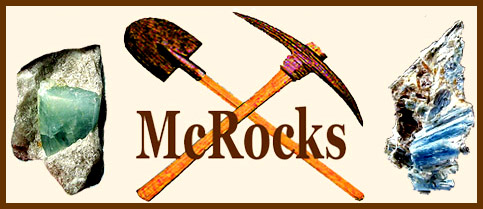  |
SLIDESHOW PAGE
Home Page
| Ruck's Pit - Fort Drum, Florida. This Dixie Mineral Council sponsored field trip hosted by Mickey and Barbara Cecil with the Jacksonville Gem and Mineral society took place on January 18, 2003. Click on the following link to start the slideshow. New Mexico and Utah Rockhounding Vacation in May 2002. We collected at the following minerals at the following locations: 1. Blue Fluorite - Desert Rose Mine - Blanchard Claims - Bingham, New Mexico. We showed up on a Monday morning after arranging by email to meet the owner at her rock shop in Bingham. Ms. Nilsen never showed up. We learned from neighbors that she always takes Mondays off to head into nearby Socorro for shopping, etc and her boyfriend and partner was out of town. The neighbor was kind enough to take our names and the $20.00 fee ($10 each)and to give us directions to the mine located in the desert about 3.1 miles from the rock shop. We spent the entire day in the hot sun the working the very hard dolostone walls with sledges, chisels and prypars outside the entrance to the mine. We were able to locate veins and small pockets of fluorite but the material was mostly broken and weathered. Although unconfirmed by our visit, it is my understanding the walls inside the mine are covered with high quality blue fluorite cubes. For $200 per person, Ms. Nilsen's boyfriend guides tours inside the mine where you can take a whack at the good stuff. After our experience, I wouldn't go back to work outside the mine but might consider being led inside where you have a better chance of getting something worthwhile- just depends on our cash flow at the time. 2. Septarian Nodules - Near Orderville, Utah. We spent a day looking for Septarian Nodules in and around old mostly abandoned mining claims. We followed the directions in the "Gem Trails of Utah" book to find massive excavations as deep as 50 feet that had been dug by trackhoe into gray, poorly indurated and weathered shale. We went from hole to hole looking for fresh signs of digging and leaverites. After half the day had gone by with no luck, we found a hole that looked good (relatively fresh signs of digging and plenty of leaverites scattered around). I took a few whacks into the bottom side of the excavation and uncovered the end of a large Septarian nodule (geode). This one looked like it had part of one side broken off by the edge of the trackhoe bucket; you could see right into the interior pocket lined with yellow calcite crystals - lucky me! I used pick, shovel, chisels and prybar to liberate the 8" diameter geode from the wall. During the next couple hours of very hard and hot work I was able to recover a couple more decent size nodules/geodes and several smaller ones from the same layer of shale. I have since had one of the larger ones cut and it has a hollow center portion filled with small yellow dog-tooth calcite crystals that are characteristic of the Septarians. I was able to hand polish the cut Septarian in only about an hour. 3. Petrified Wood - Cinder Mountain - ~16 miles east of Hurricane, Utah. We traveled about 13 miles east of Hurricane on Hwy 59 and turned right (south) on Cinder Mountain Road. We drove about 4 miles on Cinder Mountain Road that led up to a Mesa (shown on a USGS map as Little Creek Mountains). Small to medium-size pieces of petrified wood could be found by walking the shallow washes on the mesa. However, we found the most wood in washes inside and around large rounded white-colored sandstone outcroppings. We found whole large trees buried in the soft soil. The wood was not particularly agazited but some was covered with beautiful small smoky quartz crystals. We had hiked in to the spot where we found the most wood so we only took out as much as we could carry. There were campfires and evidence that you could drive into the spot if you really knew your way around. Caution should be used when hiking in the sandstone washes because it is really easy to get turned around and the hot dry desert is unforgiving of mistakes. 4. Topaz - Topaz Mountain - Delta, Utah. We spent a day breaking light gray rhyolite looking for small pockets that contained sherry-colored topaz crystals. We found enough crystals in half a day to really make the trip worthwhile. The largest perfect crystal we found is about 1/2" long and sits perfectly in a small exposed pocket. We followed the directions given in an internet site to find the Topaz Mt. 5. Hourglass Selenite - Great Salt Plains National Wildlife Refuge - Jet, Oklahoma. We stopped by the Great Salt Plains National Wildlife Refuge to collect selenite crystals. We had spent a couple days there before in June 2000 and had such a good time that we were happy to return to do dig for more crystals. We arrived in Cherokee mid morning and we headed out to the selenite collecting area located on a portion of Great Salt Plains Lake that dries up each spring. With prospect of finding crystals on our minds we were undeterred by strong winds and the dark skies that loomed ominously on the horizon. We had been digging for only about an hour-and-a-half before the wind increased and it started to rain. We were tolerating the wind and occasional showers when all of a sudden the sky opened up and the rain came down in a torrent and lightening began thundering right above us. We quickly picked up our tools and made a mad dash for the truck as the former dry lake bed began to become submerged in water again. We had to drive about 300 yards through water up to a foot deep to the shoreline. It was a good thing that we had a four-wheel drive truck; otherwise, we probably would have lost our vehicle to the lake that day. It was also a good thing that we had decided to leave our pop-up camper at the shoreline before heading out onto the dry lake bed. I had a tough time hooking the trailer up to the truck in the driving rain and with thunder and lightening cracking just over my head but I managed none-the-less. Oh well - just another one of our many rockin’ adventures! In the short time that we were there, we did notice that the collecting didn't seem as good this year as it had the previous time. There crystals were shallower but much smaller. The groundwater recharge in our holes was far less than the other time that we were there which made the recovery of crystals more difficult. The recent rains will probably fix that problem though. There are four or five separate collecting locations that are worked on a rotating basis each year. This is done to allow the selenite crystals to regenerate. Some areas and some years are better than others depending upon various factors. We had a great time sightseeing and collecting some beautiful specimens as you can see by our pictures. Click on the following link to start the slideshow. Graves Mountain - Lincoln County, Georgia. This slideshow is a compilation of many collecting trips to this former kyanite mine and now famous collecting site in northeast Georgia. Graves Mountain is probably best known for the world's finest and largest rutile crystals although many other terrific minerals can be collected including iridescent hematite/goethite, variscite, lazulite, kyanite, pyrite, blue quartz, quartz crystals to name just some. Many mineral species can be found covered with a brilliant coating of iridescent hematite making for incredible one-of-a kind specimens. Click on the following link to start the slideshow. Much more information about Graves Mountain including many excellent pictures can be found at the Georgia Mineral Society's web page (you can go to my links page for the address). Lincoln and Jackson Counties, Kentucky, March 22-23, 2003. This slideshow features pictures taken on our rock collecting trip to the Green River in Lincoln County and the South Fork of Station Creek in Jackson County, Kentucky. The Green River area near Halls Gap is well known for geodes. The geodes can contain a variety of minerals including quartz, chalcedony, calcite, dolomite, pyrite and millerite. Some quartz-lined geodes may even contain light colored amethyst. Jackson and neighboring counties is the heart of the Kentucky agate region of the State. We spent an entire day on the South Fork of Station Creek just south of Drip Rock, Kentucky hunting the elusive Kentucky agate. I have included some pictures of the more noteworthy specimens that we found on that bright sunny weekend. Click on the following link to start the slideshow. |
